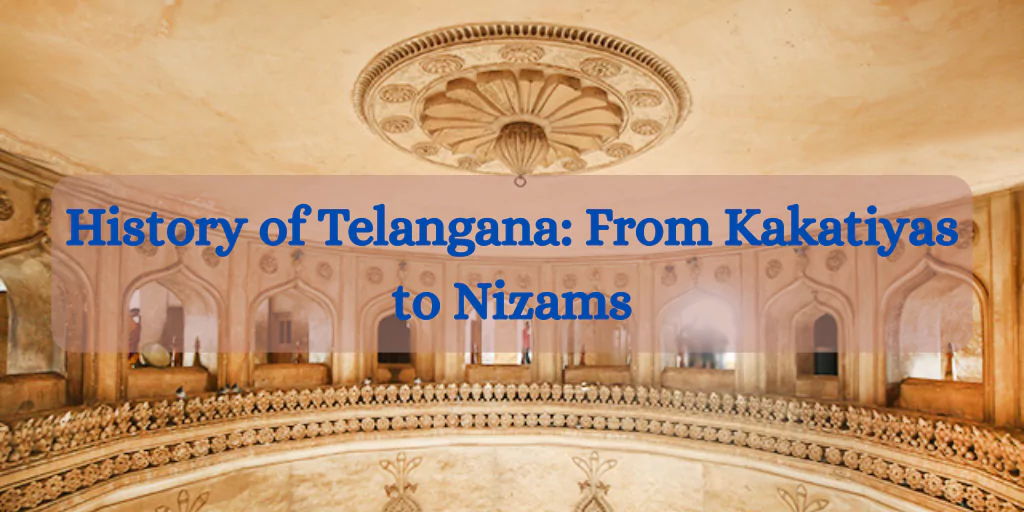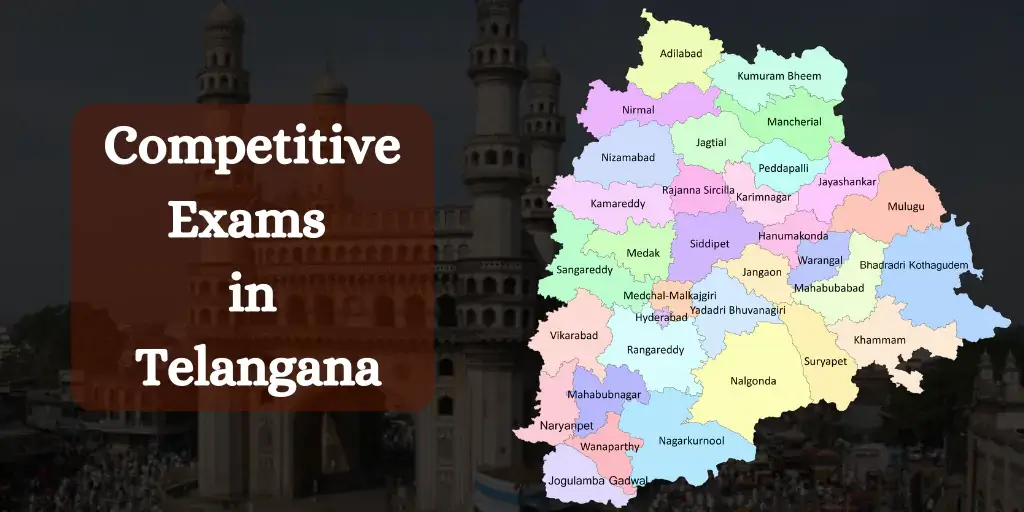Recently updated on September 8th, 2025 at 01:33 pm
Ever stood at the mighty Golconda Fort and wondered whose hands built these walls that have witnessed centuries unfold? The History of Telangana isn’t just another chapter in India’s history—it’s a vivid tapestry of power struggles, cultural renaissance, and resilient identity.
From the architectural brilliance of the Kakatiya dynasty to the opulent cultural landscape under Nizam rule, the story of Telangana reveals how this land became a melting pot of Hindu and Islamic traditions. Visitors today can still trace these influences in everything from Hyderabad’s monuments to its legendary cuisine. This blog is useful for all Group Exams, UPSC Exams and Competitive exams.
What most history books won’t tell you is how deeply intertwined Telangana’s past is with its present-day identity. And the question that puzzles even seasoned historians: how did a region repeatedly conquered manage to preserve its unique cultural essence?
1. The Ancient Roots of Telangana

A. Prehistoric Settlements Along the Godavari and Krishna Rivers
- Human settlements in Telangana date back to 100,000 BCE, especially near the Godavari and Krishna rivers.
- Palaeolithic rock paintings in Regonda and Pandavula Gutta depict hunting and gathering activities.
- During the Neolithic period (10,000–2000 BCE), communities transitioned to agriculture.
- Sites like Peddabankur show tools like grinding stones, polished axes, and pottery.
- Megalithic burial sites (e.g., Khairatabad, Hashmatpet) with iron tools reflect complex rituals and beliefs.
B. Early Dynasties That Shaped the Region
- The Satavahanas (230 BCE–220 CE) were the first major dynasty, with their capital at Kotilingala.
- They developed international trade networks, reaching as far as Rome and Southeast Asia.
- Successive dynasties included the Ikshvakus, Vishnukundinas, and Eastern Chalukyas.
- Power struggles between the Rashtrakutas and Western Chalukyas (8th–10th century) shaped the political landscape.
- Historical sites like Alampur and Vemulavada preserve ruins from these eras.
C. Cultural Foundations That Influenced Later Periods
- Buddhism thrived under Satavahana rule before Hinduism regained prominence.
- Temple architecture, especially by the Chalukyas, laid the groundwork for future Kakatiya styles (e.g., Alampur temples).
- Early literature evolved from oral traditions and rock inscriptions.
- Sanskrit and Prakrit were gradually replaced by Telugu as the primary literary language.
- The caste system and agricultural practices from this era formed the basis for later social structures.
2. Rise of the Kakatiya Dynasty

A. Emergence of the Kakatiyas as a Regional Power
- The Kakatiyas began as feudatories under the Western Chalukyas in the 11th century.
- They governed small territories around Warangal in central Telangana.
- Gained independence as Chalukyan power declined.
- Prola II and Rudra Deva played key roles in establishing them as an independent dynasty by the late 12th century.
- Originating from warrior backgrounds, not traditional Kshatriya lineage.
- Their capital, Orugallu (Warangal), became a cultural and political centre in Telangana.
B. Architectural Achievements, Including Warangal Fort and Ramappa Temple
- Warangal Fort reflects both military strength and artistic excellence.
- Fort featured concentric walls and intricately carved stone gateways (thoranas).
- Lotus medallion carvings became iconic symbols of their rule.
- Ramappa Temple, built under King Ganapati Deva, is known for:
- “Floating bricks” that are light enough to float on water.
- Sculptures depicting dynamic dance movements.
- Aesthetic use of black basalt pillars and lighter stone structures.
C. Socio-economic Reforms under Kakatiya Rulers
- Developed extensive water management systems, including tanks like Pakhal Lake.
- Enabled agriculture in semi-arid regions, boosting rural prosperity.
- Implemented the Nayankara system:
- Land grants to military chiefs (Nayakas) for troop maintenance and local governance.
- Strengthened local communities while maintaining central control.
- Promoted trade networks between coastal and interior regions, enhancing economic exchange.
D. Military Innovations and Territorial Expansion
- Relied heavily on cavalry and advanced fortification methods.
- Expanded territory from the Godavari basin to coastal Andhra, Karnataka, and Maharashtra.
- Cities like Warangal used natural water barriers and layered defences.
- Built unique round-shaped forts for maximum defence.
- An expert in guerrilla warfare, using the hilly terrain to resist invasions.
- Successfully resisted early Delhi Sultanate attacks until they fell to Ulugh Khan in 1323.
E. The Legacy of Queen Rudrama Devi
- Ruled from 1262–1289 CE as one of India’s few legitimate female monarchs.
- Gained power through skill and leadership, not just inheritance.
- Officially crowned with full sovereign authority.
- Strengthened fortifications and expanded irrigation during her reign.
- Personally led armies into battle, often dressed as a man to counter gender bias.
- Patronised literature and arts, initiating a cultural revival.
- Her reign remains a source of inspiration for women’s leadership in Telangana.
3. The Post-Kakatiya Period

A. Political Fragmentation Following Kakatiya Decline
- The Kakatiya dynasty ended in 1323 after the defeat of Prataparudra II by Muhammad bin Tughluq.
- Telangana entered a period of political instability and fragmentation.
- Various local chieftains, former nobles, and military leaders vied for power.
- The region saw constant conflicts, shifting alliances, and short-lived rulers.
- No single power was strong enough to unify Telangana after the Kakatiyas.
B. The Musunuri Nayaks and Their Brief Confederation
- Musunuri Nayaks rose around 1326, led by Prolaya Nayaka and later Kapaya Nayaka.
- They formed a confederation of Telugu warrior-chiefs to resist Delhi Sultanate control.
- Reclaimed parts of Telangana and sought to restore native rule.
- Many former Kakatiya commanders joined their cause, driven by cultural loyalty.
- Internal rivalries weakened the confederation.
- By 1370, the Musunuri movement collapsed, making way for new rulers.
C. Rise of the Bahmani Sultanate in the Deccan
- The Bahmani Sultanate was founded in 1347 by Alauddin Hasan Bahman Shah.
- It capitalised on the power vacuum in Telangana and expanded across the Deccan.
- Brought cultural and architectural influence, combining Persian and Indian styles.
- Established administrative centres and a decentralised governance structure.
- Became the dominant power in Telangana by the early 15th century.
- Initiated a lasting period of Islamic influence that continued under the Qutb Shahis and Nizams.
4. Qutb Shahi Era

A. Establishment of the Golconda Sultanate
- The Qutb Shahi dynasty emerged from the decline of the Bahmani Sultanate.
- Sultan Quli Qutb-ul-Mulk declared independence in 1518 and founded the Golconda Sultanate.
- Sultan Quli was originally from Hamadan, Persia, and served the Bahmanis before establishing his own rule.
- Golconda Fort became the centre of his kingdom.
- The Qutb Shahis ruled for nearly 170 years, with seven sultans in succession.
B. Founding and Development of Hyderabad
- Muhammad Quli Qutb Shah founded Hyderabad in 1591.
- The city was originally named “Bhagyanagar” after Bhagmati, his beloved.
- Hyderabad was a planned city, with the Charminar as its central landmark.
- The city had gridded streets, busy marketplaces, and a strategic location.
- It attracted a diverse population of merchants, artisans, and scholars.
C. Persian Influences on Art, Architecture, and Culture
- Persian culture had a profound impact during the Qutb Shahi era.
- Architectural landmarks include the Charminar, Golconda Fort, and many mosques and tombs.
- The Qutb Shahis supported Persian poetry, music, and dance.
- They also embraced Telugu and Deccani traditions, resulting in a unique cultural blend.
- This fusion gave rise to the Deccani culture, including the Dakhni language, distinctive cuisine, and dress.
D. Economic Prosperity through Diamond Trade and Agriculture
- Golconda became wealthy through control of diamond mines, especially Kollur.
- Famous diamonds like the Koh-i-Noor and Hope diamond came from this region.
- The Qutb Shahis built irrigation systems to boost agriculture.
- Notable constructions include Hussain Sagar Lake in Hyderabad.
- Trade routes connected Golconda with Asian and European markets, making it a major economic hub.
5. Asaf Jahi Dynasty and the Nizams

A. Formation of the Independent Hyderabad State
- The Asaf Jahi Dynasty began in 1724 when Mir Qamaruddin defeated the Mughal governor of the Deccan.
- He took the title Nizam-ul-Mulk and named the dynasty after Asaf, a biblical vizier.
- Initially ruled as a Mughal vassal, but by 1748, Hyderabad became de facto independent.
- Maintained ceremonial allegiance to the Mughals even as their power declined.
B. Political Relations with the Mughals and British
- The Nizams balanced Mughal decline with the rise of British power.
- After the Second Anglo-Mysore War (1784), a subsidiary alliance was signed with the British East India Company.
- British troops were stationed in Hyderabad in exchange for military protection.
- Hyderabad became the largest princely state under British colonial rule, with internal autonomy but external dependence on British support.
C. Cultural Renaissance During the Nizam Period
- Hyderabad became a cultural melting pot, blending Persian, Arabic, Turkish, Urdu, and Telugu traditions.
- Flourishing architecture – iconic landmarks include Chowmahalla Palace and Falaknuma Palace.
- Patronage of Urdu poetry, literature, music, and Dakhani culture, which mixed North and South Indian elements.
D. Socio-Economic Developments and Modernisation Efforts
- Mir Osman Ali Khan, the 7th Nizam, launched major modernisation projects.
- Founded Osmania University (1918) with Urdu as the medium of instruction.
- Led industrialisation – established factories, railways, mining, and modern banking systems.
- Constructed key irrigation projects like Nizam Sagar Dam to boost agriculture.
- However, feudal structures like the jagirdari system persisted, leading to rural inequality and later social unrest.
6. Telangana Under Colonial Influence

A. The Subsidiary Alliance with the British East India Company
- Nizam Ali Khan signed the Subsidiary Alliance in 1798 with the British East India Company.
- The Nizams received British military protection, but:
- Lost control over foreign affairs.
- Had to pay for British troops stationed in Hyderabad.
- This led to gradual British dominance:
- Resource control shifted subtly to the British.
- In 1853, the Berar region was taken by the British for debt repayment.
- By the 20th century, Nizam Osman Ali Khan ruled in appearance, but real power rested with the British.
B. Operation Polo and Integration into the Indian Union
- After Indian independence (1947), Nizam Osman Ali Khan refused to join India or Pakistan.
- The Indian government launched Operation Polo in September 1948:
- Also called a “Police Action”.
- The Indian Army entered Hyderabad and ended the Nizam’s rule in just five days.
- This marked the end of the Asaf Jahi dynasty and Hyderabad’s status as a princely state.
- It also ended over two centuries of semi-independent rule in Telangana.
C. Struggles for Maintaining Regional Identity
- In 1956, Hyderabad State was merged with Andhra State to form Andhra Pradesh.
- This merger ignored Telangana’s cultural and historical distinctiveness.
- Resulted in dissatisfaction and marginalisation of Telangana in:
- Language and dialect
- Resource allocation
- Employment and education opportunities
- Led to the Telangana Rebellion (1969):
- Mass protests, especially by students and youth.
- Demanded separate statehood and preservation of Telangana’s identity.
- Though the 1969 movement was suppressed, it sowed the seeds for future movements.
- Persistent activism over decades finally led to the formation of Telangana State in 2014.
7. The Path to Statehood

A. Early Movements for Separate Statehood
- Post-Independence Integration:
- After India’s independence in 1947, the Nizam of Hyderabad initially resisted joining India.
- After Operation Polo (1948), Hyderabad State became part of India.
- The 1956 Merger:
- The States Reorganisation Commission merged Telangana with Andhra State to form Andhra Pradesh based on language.
- The Gentlemen’s Agreement promised to protect Telangana’s interests, but these promises were not fulfilled.
- 1969 Agitations:
- The first major push for separate statehood arose in 1969, when students and citizens protested.
- They demanded the implementation of safeguards and, later, a separate Telangana.
B. The Telangana Rebellion of 1946-51
- Background:
- Before independence, Telangana saw one of the largest peasant uprisings in India, called the Telangana Rebellion.
- Communist-led resistance targeted the feudal Jagirdari system under Nizam rule.
- Peasant Revolt:
- Peasants revolted against oppressive landlords who imposed high taxes and forced unpaid labour.
- The movement spread across 3,000 villages, and peasants set up their governance.
- Outcome:
- The rebellion redistributed around 1 million acres of land to landless farmers.
- The movement continued until 1951, when communist leaders shifted to electoral politics, but it remained a significant symbol for resistance.
C. Political Developments Post-Independence
- Post-1969:
- The 1969 movement subsided, and for decades, there was little political action for statehood.
- 1990s and the Rise of TRS:
- In the 1990s, the Telangana Rashtra Samithi (TRS) was founded by K. Chandrashekar Rao in 2001, focusing on the demand for statehood.
- 2004 TRS Growth:
- The TRS formed an alliance with Congress in the 2004 elections, gaining political influence.
- Intensified Agitations (2009-2013):
- Hunger strikes, mass protests, and resignations became common.
- Major movements included the Million March and Sakala Janula Samme (General Strike).
- These movements kept the statehood demand alive and in the national consciousness.
D. Final Formation of Telangana State in 2014
- Decisive Action:
- On July 30, 2013, the Congress Working Committee recommended forming Telangana.
- The proposal was approved by the Union Cabinet in October 2013.
- Formation Date:
- The Andhra Pradesh Reorganisation Act was passed in February 2014.
- June 2, 2014, became the official formation date of Telangana as India’s 29th state.
- K. Chandrashekar Rao’s Leadership:
- K. Chandrashekar Rao was sworn in as the first Chief Minister of Telangana.
- Challenges:
- The new state faced challenges such as resource-sharing, water disputes, and power distribution.
- Hyderabad was designated as the joint capital for 10 years.
Conclusion
Telangana’s rich history spans from ancient kingdoms to its modern identity as an Indian state. It witnessed the rise of powerful dynasties like the Kakatiyas, who left architectural marvels like Warangal Fort, followed by the Qutb Shahis, who founded Hyderabad, and the Nizams, who turned it into a cultural and economic hub. Despite periods of conquest, resistance, and colonial influence, Telangana has maintained a strong cultural identity.
The struggle for statehood reflects this long history, showcasing the people’s determination to preserve their heritage while progressing. Today, Telangana’s cultural legacy shapes its art, cuisine, festivals, and social fabric, offering valuable insight into the region’s unique place in India’s cultural landscape.






